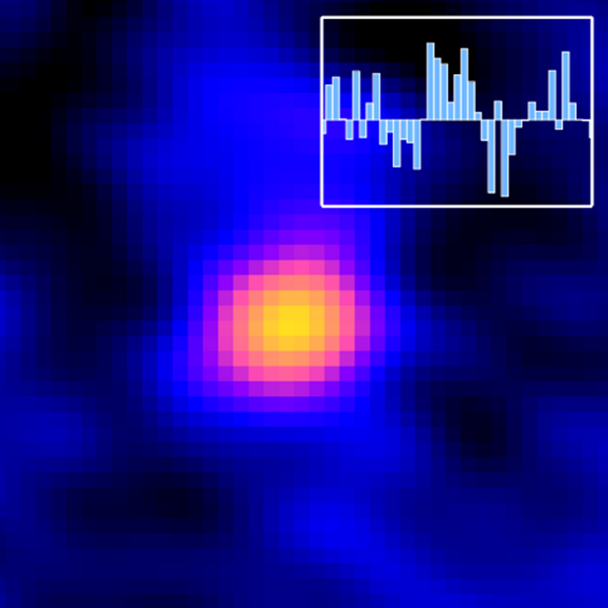DATE2022.11.28 #Press Releases
Toward unveiling the cosmic mystery of Fast Radio Bursts
To understand the birth environments of the Fast Radio bursts, a new study probes the molecular gas of their host galaxies.
November 28, 2022
Since 2007, astronomers have been observing fleeting bursts of bright, energetic radio waves lasting milliseconds to microseconds in space. They call them Fast Radio Bursts (FRBs). But what produces these high-energy bursts baffles astronomers. To understand the origins of FRBs, a team of scientists from the University of Tokyo, the National Chung Hsing University, and the National Tsing Hua University probed the birth environments of FRBs. They published the study in The Astrophysical Journal Letters.
“FRBs are like radio fireworks in the Universe with unknown origins,” says Tetsuya Hashimoto, an Assistant Professor at the National Chung Hsing University, and an author of the research article.
“Because of the extremely bright nature of FRBs, they are expected to be used as probes of the distant universe. In addition, understanding the origin and mechanism of FRBs is thought to be closely related to other transient phenomena and is expected to significantly impact other research fields,” adds Bunyo Hatsukade, an Assistant Professor at the University of Tokyo and the article's first author.
Thousands of FRBs originate from within and outside our galaxy. The host galaxies differ in shape, mass, and the rate at which dust and gas turn into stars. Pinning down the exact source of the FRBs is challenging. But molecular gas which fuels star formation can provide clues to the origin of FRBs. So, analyzing the molecular gas of the galactic environments of FRBs may hint at how they occur and where they originate.
To characterize molecular gas, scientists analyze the electromagnetic spectrum emitted from interstellar sources. The emission spectrum reveals signatures of various known molecules and processes. For example, emission spectral lines associated with interstellar carbon monoxide (CO) can tell us about the new star formation processes. To capture the emission spectra data, the scientists used a set of telescopes called the Atacama Large Millimeter/submillimeter Array (ALMA) located in the Atacama Desert in Chile (Figure 1).

Figure 1 : Schematic view of the study. Scientists detected the signal of molecular gas from the host galaxy of FRB 360 million light-years away using the ALMA telescope. The top left image is the map of molecular gas in the galaxy based on the actual data. The blue line shows the emission spectrum from the galaxy.
The team observed the molecular gas in the host galaxy of FRB 20190711A. Then they analyzed the data along with publicly available ALMA data on two other FRBs: FRB20180924B (Figure 2) and FRB 20190102C. By adding published data on three other FRBs, a total of six FRB host samples were constructed. They compared the molecular gas properties of the six FRB host galaxies to other galaxies with no known FRBs. The other galaxies included normal star-forming galaxies and host galaxies of long-duration gamma-ray bursts and core-collapse supernovae (which are explosions due to the death of giant stars).
Compared to other local star-forming galaxies, the host galaxies of FRBs varied in their molecular gas properties. For example, the FRB20180924B host galaxy is molecular gas-rich. But hosts of FRBs 20190102C and 20200120E are molecular gas-poor. The host galaxies also varied in their properties such as molecular gas mass, luminosity, star formation rate, etc.
If the FRBs originate from massive stars, their host environment should be rich in molecular gas. But, if they originate from old neutron stars and white dwarfs, their environment should be poor in molecular gas. Because this study found both possibilities, the scientists could not generalize the exact host galaxy environment for FRB origins. The scientists concluded that the FRBs may originate from many ancestors or single ancestors in a wide range of host galaxy environments.

Figure 2 :The study obtained a map of molecular gas distribution of the host galaxies of Fast Radio Bursts. The image shows a schematic of one such molecular gas distribution. Inset is the spectrum of carbon monoxide, a tracer of molecular gas.
The cosmic expedition for the mysterious Fast Radio Bursts continues.
“Even with one of the most advanced telescopes, ALMA, it is challenging to detect signals from distant galaxies. This study has confirmed the importance of molecular gas observations, and we would like to expand the sample further in the future,” says Dr. Hatsukade.
Link : National Chung Hsing University
Publication details
Journal The Astrophysical Journal Letters Title Diverse properties of molecular gas in the host galaxies of Fast Radio BurstsAuthors Bunyo Hatsukade, Tetsuya Hashimoto, Yuu Niino, and Tzu-Yin HsuDOI


